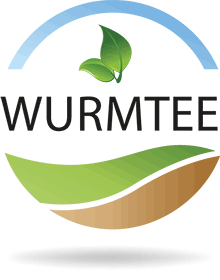Vielfalt der Bakterien, die mit Regenwurmdarmmikroflora verbunden sind und deren Wirkungen auf chemische Prozesse in Boden und Bodenmikroflora:
- Petersen H, Luxton MA (1982) A comparative analysis of soil fauna populations and their role in decomposition process. Oikos 39:287-388
- Lee KE (1985) Earthworms: Their Ecology and Relationships with Soils and Land Use. Academic Press, Sydney.
- Edwards CA, Bohlen PJ (1996) Biology and Ecology of earthworms. Chapman and Hall, London. p 426
Komplexe Interaktionen zwischen für Pflanzenwachstum rhizosphäre Bakterien, wie Pseudomonas, Rhizobium, Bacillus, Azosprillium, Azotobacter, und Rhizosphäre im Boden und Stimulation von Pflanzenwachstum durch Erhöhung von Wasserlöslichkeiten der Nährstoffe:
- Sinha RK, Agarwal S, Chauhan K, Valani D (2010) The wonders of earthworms and its vermicompost in farm production: Charles Darwin’s ‘friends of farmers’, with potential to replace destructive chemical fertilizers from agriculture. Agricultural sciences 1:76-94
- Ayyadurai N, Ravindra Naik P, Sakthivel N (2007) Functional characterization of antagonistic fluorescent pseudomonads associated with rhizospheric soil of rice (Oryza sativa L.). J Microbiol Biotechnol 17:919-927
- Ravindra NP, Raman G, Badri Narayanan K, Sakthivel N (2008) Assessment of genetic and functional diversity of phosphate solubilizing fluorescent pseudomonads isolated from rhizospheric soil. BMC Microbiol 8:230
Produktion von Wachstumshormonen wie Aminocyclopropancarbonsäure und Deaminase:
- Correa JD, Barrios ML, Galdona RP (2004) Screening for plant growth promoting rhizobacteria in Chamaecytisus proliferus (tagasaste), a forage tree-shrub legume endemic to the Canary Islands. Plant Soil 266:75-84
Stickstoff-Fixierung, Unterdrückung von pathogenen Pilzen durch Produktion von Antibiotika, Siderophoren und Pilzzellwandabbauenden Enzymen wie Chitinasen und Glucanasen:
- Han J, Sun L, Dong X, Cai Z, Yang H, Wang Y, Song W (2005) Characterization of a novel plant growth-promoting bacteria strain Delftia tsuruhatensis HR4 both as a diazotroph and a potential biocontrol agent against various pathogens. Syst Appl Microbiol 28:66-76
- Sunish KR, Ayyadurai N, Pandiaraja P, Reddy AV, Venkateshwarlu Y, Prakash O, Sakthivel N (2005) Characterization of antifungal metabolite produced by a new strain Pseudomonas aeruginosa PuPa3 that exhibits broad-spectrum antifungal activity and biofertility traits. J Appl Microbiol 98:145-154
- Ravindra NP, Raman G, Badri Narayanan K, Sakthivel N (2008) Assessment of genetic and functional diversity of phosphate solubilizing fluorescent pseudomonads isolated from rhizospheric soil. BMC Microbiol 8:230
- Jha BK, Gandhi Pragash M, Cletus J, Raman G, Sakthivel N (2009) Simultaneous phosphate solubilization potential and antifungal activity of new fluorescent pseudomonad strains, Pseudomonas aeruginosa, P. plecoglossicida and P. mosselii. W J Microbiol Biotech 25:573-581
- Pathma J, Ayyadurai N, Sakthivel N (2010) Assessment of Genetic and Functional Relationship of Antagonistic Fluorescent Pseudomonads of Rice Rhizosphere by Repetitive Sequence, Protein Coding Sequence and Functional Gene Analyses. J Microbiol 48:715-727
- Pathma J, Kamaraj Kennedy R, Sakthivel N (2011a) Mechanisms of fluorescent pseudomonads that mediate biological control of phytopathogens and plant growth promotion of crop plants. In: Maheswari DK (ed) Bacteria in Agrobiology: Plant Growth Responses, SpringerVerlag, Berlin. pp 77-105
- Ismail SA (1995) Earthworms in soil fertility management. In: Thampan PK (ed) Organic Agriculture, pp. 77-100
Mineralisierung von organischer Substanz und Erleichterung der Chelatisierung von Metall-Ionen:
- Pizl V, Novokova A (1993) Interactions between microfungi and Eisenia andrei (Oligochaeta) during cattle manure vermicomposting. Pedobiologia 47:895-899
- Canellas LP, Olivares FL, Okorokova FAR (2002) Humic acids isolated from earthworm compost enhance root elongation, lateral root emergence and plasma membrane H+− ATPase activity in maize roots. Plant Physiol 130:1951-1957
Anstieg der Zahl der positiven Bakterien in, von Würmern verdauter Erde:
- Parle JN (1963) A Microbiological Study of Earthworm Casts. J Gen Microbiol 31:13-22
- Edwards CA, Lofty R (1977) The Biology of Earthworms. Chapmann and Hall, London.
- Edwards CA, Fletcher KE (1988) Interaction between earthworms and microorganisms in organic matter breakdown. Agric Ecosyst Environ 20:235-249
- Parle JN (1963) A Microbiological Study of Earthworm Casts. J Gen Microbiol 31:13-22
- Daniel O, Anderson JM (1992) Microbial biomass and activity in contrasting soil material after passage through the gut of earthworm Lumbricus rubellus Hoffmeister. Soil Biol Biochem 24:465-470
- Pedersen JC, Hendriksen NB (1993) Effect of passage through the intestinal tract of detritivore earthworms (Lumbricus spp.) on the number of selected gram-negative and total bacteria. Biol Fertil Soils 16:227-232
- Devliegher W, Verstraete W (1995) Lumbricus terrestris in a soil core experiment: nutrient-enrichment processes (NEP) and gut-associated processes (GAP) and their effect on microbial biomass and microbial activity. Soil Biol Biochem 27:1573-1580
- Bohlen PJ, Edwards CA (1995) Earthworm effects on N dynamics and soil respiration in microcosms receiving organic and inorganic nutrients. Soil Biol Biochem 27:341-348
- Devliegher W, Verstraete W (1995) Lumbricus terrestris in a soil core experiment: nutrient-enrichment processes (NEP) and gut-associated processes (GAP) and their effect on microbial biomass and microbial activity. Soil Biol Biochem 27:1573-1580
- Scheu S (1992) Automated measurement of the respiratory response of soil micro-compartments: active microbial biomass in earthworm faeces. Soil Biol Biochem 24:1113-1118
- Khambata SR, Bhat JV (1953) Studies on a new oxalate-decomposing bacterium, Pseudomonas oxalaticus. J Bacteriol 66:505-507
- Contreras E (1980) Studies on the intestinal actinomycete flora of Eisenia lucens (Annelida, Oligochaeta). Pedobiologia 20:411-416
- Jolly JM, Lappin-Scott HM, Anderson JM, Clegg CD (1993) Scanning electron microscopy of the gut microflora of two earthworms: Lumbricus terrestris and Octolasion cyaneum. Microbial Ecol 26:235-245
- Citernesi U, Neglia R, Seritti A, Lepidi AA, Filippi C, Bagnoli G, Nuti MP, Galluzzi R (1977) Nitrogen fixation in the gastro-enteric cavity of soil animals. Soil Biol Biochem 9:71-72
- Karsten GR, Drake HL (1995) Comparative assessment of the aerobic and anaerobic microfloras of earthworm guts and forest soils. Appl Environ Microbiol 61:1039-1044
- Singleton DR, Hendrixb PF, Colemanb DC, Whitmana WB (2003) Identification of uncultured bacteria tightly associated with the intestine of the earthworm Lumbricus rubellus (Lumbricidae; Oligochaeta). Soil Biol Biochem 35:1547-155
- Binet F, Fayolle L, Pussard M (1998) Significance of earthworms in stimulating soil microbial activity. Biol Fertil Soils 27:79-84
- Vivas A, Moreno B, Garcia-Rodriguez S, Benitez E (2009) Assessing the impact of composting and vermicomposting on bacterial community size and structure, and functional diversity of an olive-mill waste. Bioresour Technol 100:1319-1326
- Suhane RK (2007) Vermicompost. Publication of Rajendra Agriculture University, Pusa.
- Yasir M, Aslam Z, Kim SW, Lee SW, Jeon CO, Chung YR (2009) Bacterial community composition and chitinase gene diversity of vermicompost with antifungal activity. Bioresour Technol 100:4396-4403
- Parthasarathi K, Ranganathan LS (1998) Pressmud vermicast are hot spots of fungi and bacteria. Ecol Environ Cons 4:81-86
- Haritha Devi S, Vijayalakshmi K, Pavana Jyotsna K, Shaheen SK, Jyothi K, Surekha Rani M (2009) Comparative assessment in enzyme activities and microbial populations during normal and vermicomposting. J Environ Biol 30:1013-1017
- Tiwari SC, Tiwari BK, Mishra RR (1989) Microbial populations, enzyme activities and nitrogen, phosphorous, potassium enrichment in earthworm casts and in the surrounding soil of pine apple plantation. Biol Fertil Soils 8:178-182
- Toyota K, Kimura M (2000) Microbial community indigenous to the earthworm Eisenia foetida. Biol Fertil Soils 31:187-190
- Devliegher W, Verstraete W (1997) Microorganisms and soil physicochemical conditions in the drilosphere of Lumbricus terrestris. Soil Biol Biochem 29:1721-1729
- Kristufek V, Ravasz K, Pizl V (1993) Actinomycete communities in earthworm guts and surrounding soil. Pedobiologia 37:379-384
Zusammenhang der enzymatischen Aktivität von Cellulase, Amylase, Invertase, Protease, Peroxidase, Urease, Phosphatase, Dehydrogenase usw. mit Mikrobenpopulation in Wurmhumus:
- Tiquia SM (2005) Microbiological parameters as indicators of compost maturity. J Appl Microbiol 99:816-828
- Sharpley AN, Syers JK (1976) Potential role of earthworm casts for the phosphorous enrichment of runoff waters. Soil Biol Biochem 8:341-346
- Trevors JT (1984) Dehydrogenase activity in soil. A comparison between the INT and TTC assay. Soil Biol Biochem 16:673-674
- Garcia C, Hernandez T, Costa F (1997) Potential use of dehydrogenase activity as an index of microbial activity in degraded soils. Commun Soil Sci Plant Anal 28:123-134
- Haritha Devi S, Vijayalakshmi K, Pavana Jyotsna K, Shaheen SK, Jyothi K, Surekha Rani M (2009) Comparative assessment in enzyme activities and microbial populations during normal and vermicomposting. J Environ Biol 30:1013-1017
- Singleton DR, Hendrixb PF, Colemanb DC, Whitmana WB (2003) Identification of uncultured bacteria tightly associated with the intestine of the earthworm Lumbricus rubellus (Lumbricidae; Oligochaeta). Soil Biol Biochem 35:1547-1555
- Vaz-Moreira I, Maria E, Silva CM, Manaia Olga C, Nunes (2008) Diversity of Bacterial Isolates from Commercial and Homemade Composts. Microbial Ecol 55:714-722
- Pinel N, Davidson SK, Stahl DA (2008) Verminephrobacter eiseniae gen. nov., sp. nov., a nephridial symbiont of the earthworm Eisenia foetida (Savigny). Int J Syst Evol Microbiol 58:2147-2157
- Byzov BA, Nechitaylo TY, Bumazhkin BK, Kurakov AV, Golyshin PN, Zvyagintsev DG (2009) Culturable microorganisms from the earthworm digestive tract. Microbiology 78:360-368
- Zhang BG, Li GT, Shen TS, Wang JK, Sun Z (2000) Changes in microbial biomass C, N, and P and enzyme activities in soil incubated with the earthworms Metaphire guillelmi or Eisenia foetida. Soil Biol Biochem 32:2055-2062
- Aira M, Monroy F, Dominguez J (2007) Earthworms strongly modify microbial biomass and activity triggering enzymatic activities during vermicomposting independently of the application rates of pig slurry. Sci Total Environ 385:252-261
- Vivas A, Moreno B, Garcia-Rodriguez S, Benitez E (2009) Assessing the impact of composting and vermicomposting on bacterial community size and structure, and functional diversity of an olive-mill waste. Bioresour Technol 100:1319-1326
- Nechitaylo TY, Yakimov MM, Godinho M, Timmis KN, Belogolova E, Byzov BA, et al. (2010) Effect of the earthworms Lumbricus terrestris and Aporrectodea caliginosa on bacterial diversity in soil. Microbial Ecol 59:574-58


